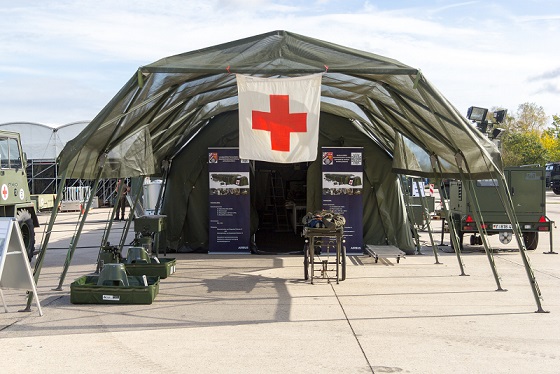Disaster can strike in the blink of an eye. Whether it’s a powerful earthquake, a chaotic hurricane, or a catastrophic war, the world, as you know it, can change drastically in an instant.
In crucial times, there’s a high demand for immediate, accessible medical care. Traditional hospitals, though indispensable, may be overwhelmed by the sudden influx of patients or be completely out of service. This is where deployable field hospitals come in.
A deployable field hospital is a cavalry rushing to the front lines when disaster strikes, armed not with weapons but with life-saving supplies and trained personnel. Think of it as a mobile, fully-equipped healthcare facility ready to roll into action at any time.
Field hospitals don’t just provide care but also hope when all else is lost. In this article, you’ll understand the role field hospitals play in disaster management, from their rapid deployment to their role in disease control and rehabilitation efforts.
Ensuring Rapid Response
When disaster strikes, quick action is critical. This is where the rapid response of deployable field hospitals shines:
- Speedy Deployment: Field hospitals are designed for immediate action. When disaster strikes, they can be up and running in a matter of hours, providing quick medical relief.
- Mobility: Another great thing about field hospitals is their mobility. It’s like a well-oiled machine, able to relocate wherever it’s needed.
- Fully Equipped: Field hospitals don’t skimp on necessary medical equipment despite being mobile. This ensures you’re not just getting quick aid but also high-quality care.
Field hospitals are the first line of defense against health crises during catastrophic events. They embody agility and efficiency in disaster management, stepping in when traditional medical facilities are inaccessible or non-operational.
Promoting Efficient Patient Triage
Patient triage is one of the crucial steps field hospitals undertake in the wake of a disaster. This refers to categorizing patients according to the severity of their injuries. The following points detail this process:
- Initial Assessment: When you enter a field hospital, a medical professional will evaluate your condition and prioritize your treatment based on urgency. The most severe cases receive immediate attention.
- Life-Saving Procedures: Life-saving interventions, such as stabilization techniques and emergency surgeries, may be provided in field hospitals if the situation calls for them.
- Referral And Transport: If your injuries require more intensive care, the field hospital team will refer and arrange transport to the nearest hospital with better equipment.
Patient triage is all about speed, efficiency, and prioritizing needs. This fast-paced, structured approach makes all the difference in saving lives when every second counts.
Containing Infectious Diseases
In the wake of a disaster, the threat of infectious diseases is too high, and it’s here field hospitals show their worth. Let’s break down why they’re essential in the containment of infectious diseases:
- Quarantine Zones: Field hospitals have specific areas for quarantine. This allows medical personnel to separate infected individuals from the general patient population, which helps prevent further spread of disease.
- Medical Expertise: Field hospitals are staffed by highly skilled professionals trained in dealing with infectious diseases. They are equipped to diagnose and treat these conditions promptly.
- Health Education: Education is a powerful tool in disease prevention. Field hospitals can provide affected communities with essential health information, teaching them practices that could help prevent the spread of the disease.
Field hospitals act as stalwarts against infectious diseases. Its role in diagnosis, treatment, and education helps keep conditions in check, ensuring the safety of the affected community. This is yet another reason why the role of field hospitals is so crucial in disaster management.
Rebuilding Health Infrastructure

When a disaster strikes, health infrastructures often take the hardest hit. This is where field hospitals become more crucial. Here’s a closer look at how they help in rebuilding health infrastructure:
- Filling The Gaps: When traditional healthcare systems are compromised, field hospitals step in to fill the void. They ensure continuous access to immediate medical care, acting as a temporary hospital until primary healthcare facilities are restored.
- Providing Continuity: They help maintain the continuity of healthcare services. Whether it’s routine checkups or managing chronic conditions, these facilities ensure that your health needs don’t get sidelined amid recovery efforts.
- Training Local Staff: These facilities often involve training local healthcare workers, enhancing the community’s resilience. So, if another disaster were to strike in the future, your local community would be better equipped to handle it.
From providing immediate healthcare services to training local staff, field hospitals ensure no one is left behind. Their role is fundamental in creating a bridge between quick disaster response and long-term recovery—indeed, the pillars of resilience in the face of adversity.
Final Words
Field hospitals are an invaluable tool in the arsenal of disaster management. Their role in providing rapid medical assistance, promoting efficient triage, containing infectious diseases, and rebuilding health infrastructure cannot be overstated.
They embody the true spirit of humanitarian aid, providing hope and care in situations where both can be hard to come by. As disasters become increasingly common, the importance of field hospitals will only continue to grow.
You must be logged in to post a comment.